/https://static.texastribune.org/media/files/4b84002233fc494a65eb337918001667/Uvalde%20Nursing%20Home%20COVID%20MG%20TT%2041.jpg)
COVID-19 ravaged Texas nursing homes. Here are the stories behind the numbers.
When the COVID-19 pandemic reached Texas last spring, administrators in the state’s 1,200 nursing homes scrambled to keep up with daily changes to state and federal guidelines on how to keep the virus from invading their facilities, while staffers donned full protective gear to keep from spreading the virus between patient rooms. Facilities were locked down, isolating vulnerable residents from their families for a year.
Still, the virus got in.
One year into the pandemic, COVID-19 has taken a heavy toll in nursing homes and other long-term care facilities. When the coronavirus invaded nursing homes in March 2020, 1 in 5 infected people older than 80 had to be hospitalized, and nearly 8% of them died.
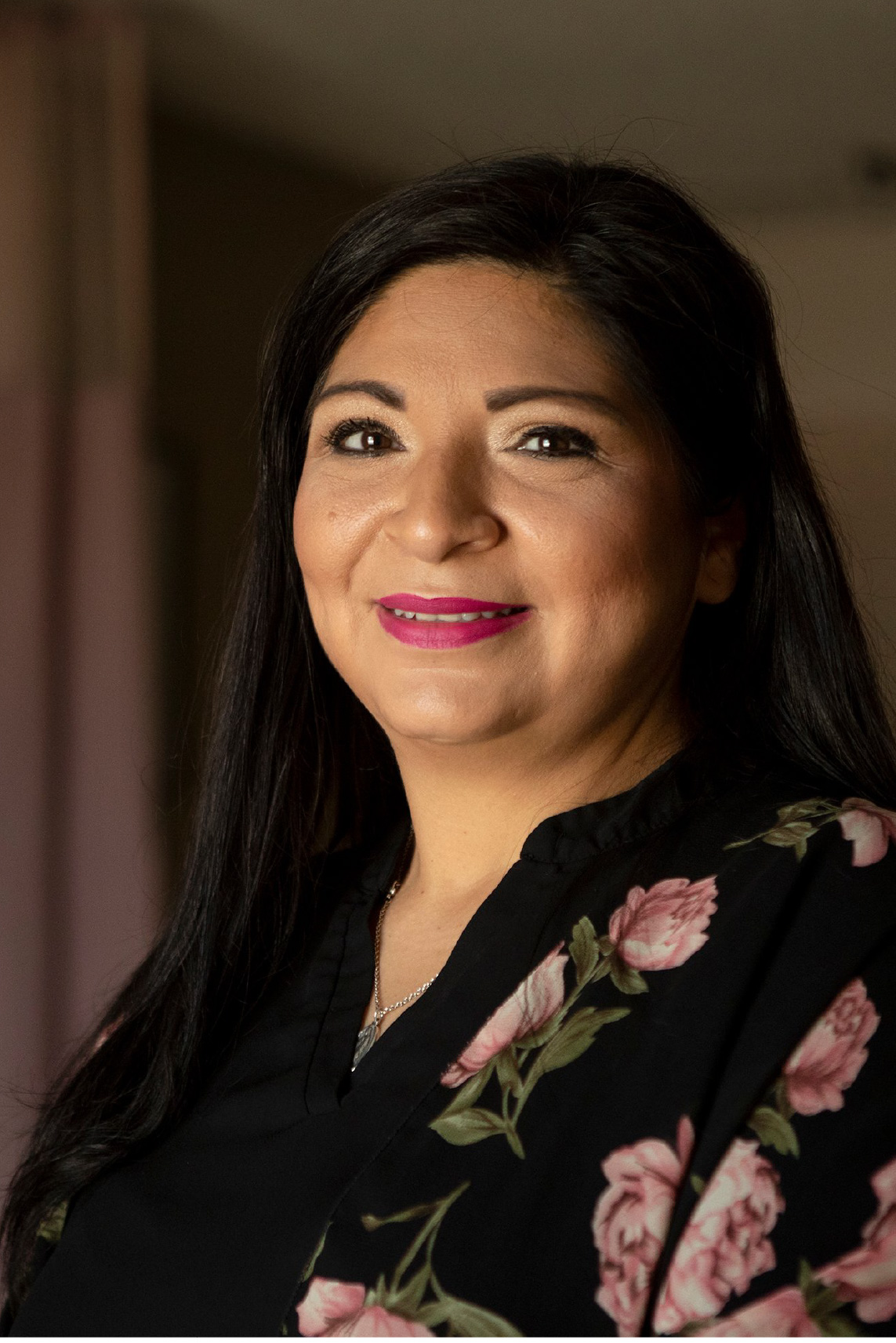
As of April 14, 8,961 nursing home residents with COVID-19 have died in Texas — nearly 10% of the state’s estimated 90,000 nursing home residents. That’s about 20% of the COVID-19-related deaths reported for the state. More than a dozen facilities lost at least 30 residents to the virus.
“It’s just a monster,” said Cristina Arizmendi Mirelez, administrator of the Amistad Nursing and Rehabilitation Center in Uvalde, which cared for about 100 people when the pandemic began and reported 10 deaths and 41 total COVID-19 cases to the state over the past year.
One year ago this month, the state released its first data showing the toll the pandemic was taking on nursing home residents. By Easter 2020, 1 in 6 COVID-19 related deaths in Texas were nursing home residents.
Within a month, the death toll in Texas nursing homes reached nearly 500.
The following 12 months would bring nightmarish death tolls, isolation, panic and grief for hundreds of thousands of nursing residents, staff and families.

“It scared me.”
Lynda Langford and her husband, Ray, raised their son on their 4,000-acre ranch in Uvalde, about 90 miles west of San Antonio. She taught English and computer skills at the local high school before retiring two decades ago.
In 2019, 74-year-old Lynda took a spill in their home out in the country and broke her arm and shoulder. The pain medication made her dizzy, and even after she stopped taking the meds, her falls happened more frequently. Home care was hard to come by in their rural area.
When the pandemic hit, the couple was close to making a difficult decision to move Lynda into long-term care so she wouldn’t be home alone while Ray was working on the ranch.
“I’ve never been away from home without my husband,” she said. “It scared me.”
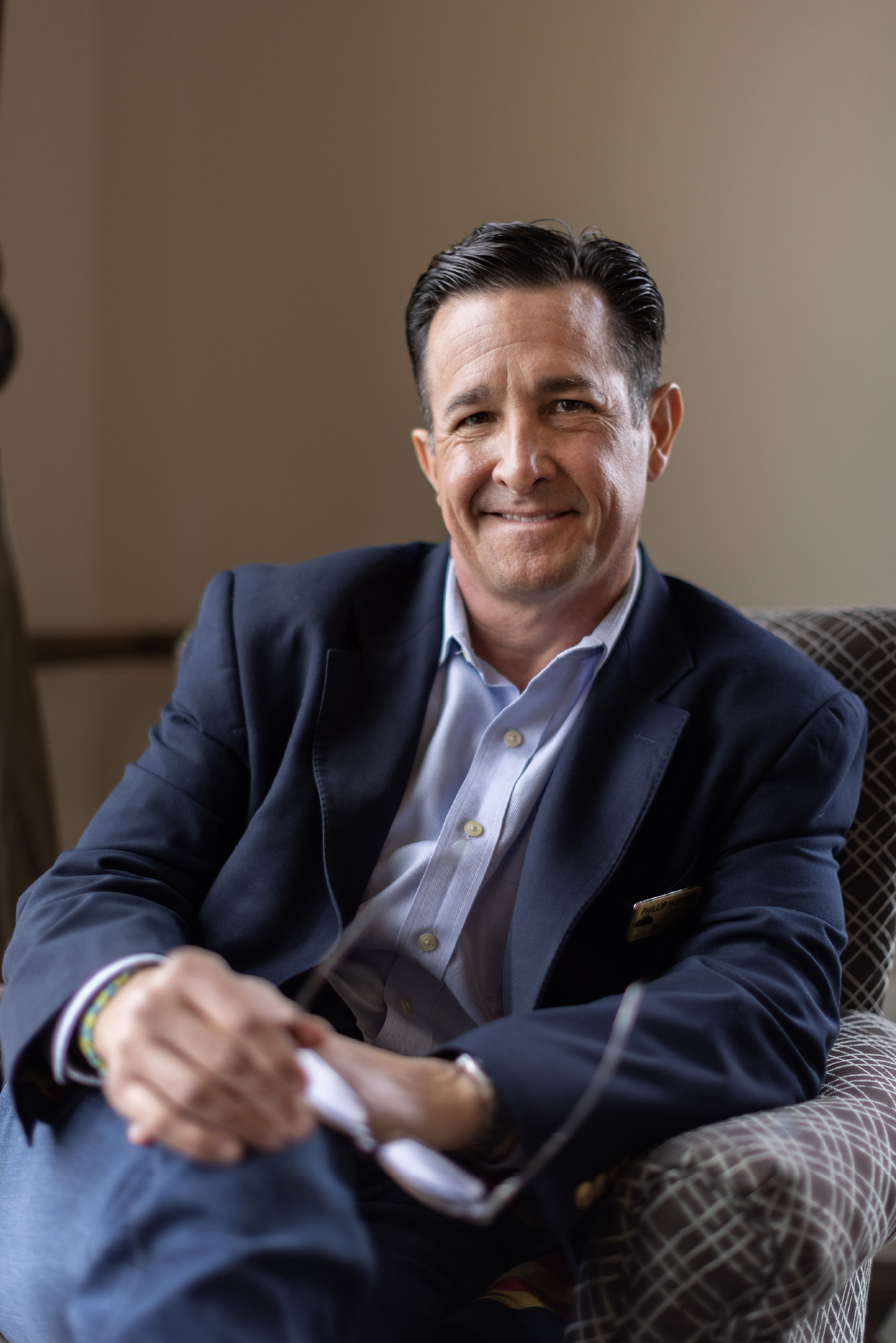
Phillip Hopkins, president of TAG Management Services, which runs nine rural nursing homes including Amistad, where Langford would soon be living, wasn’t particularly worried about early reports about the coronavirus, which seemed like another virus scare that would likely fizzle out.
“I was watching the news, and I thought, ‘This is going to be another swine flu or something like that,’” said Hopkins, a 25-year veteran of the business.
When the novel coronavirus outbreak became a full-fledged global pandemic, he said, “We were all on our heels. We had a pandemic plan, but we'd never really dealt with it before.”
Then, in March 2020, cases of the virus began showing up in Texas nursing homes.
“That first case, it’s like your heart stopped,” Hopkins said.
A chaotic beginning
Arizmendi Mirelez couldn’t believe the phone call she received from Hopkins in mid-March, instructing her to shut down the Amistad facility to visitors the following day as part of the governor’s statewide disaster declaration and on orders from federal officials.
“My facility was always full of families and visitors, and to think that I have to lock those doors and not let anyone in was unheard of,” she said. “It was scary for my residents. I thought, ‘What are they going to do? They’re so used to their wives or daughters or sons being here every single day. How are we going to fill that void for them?’”
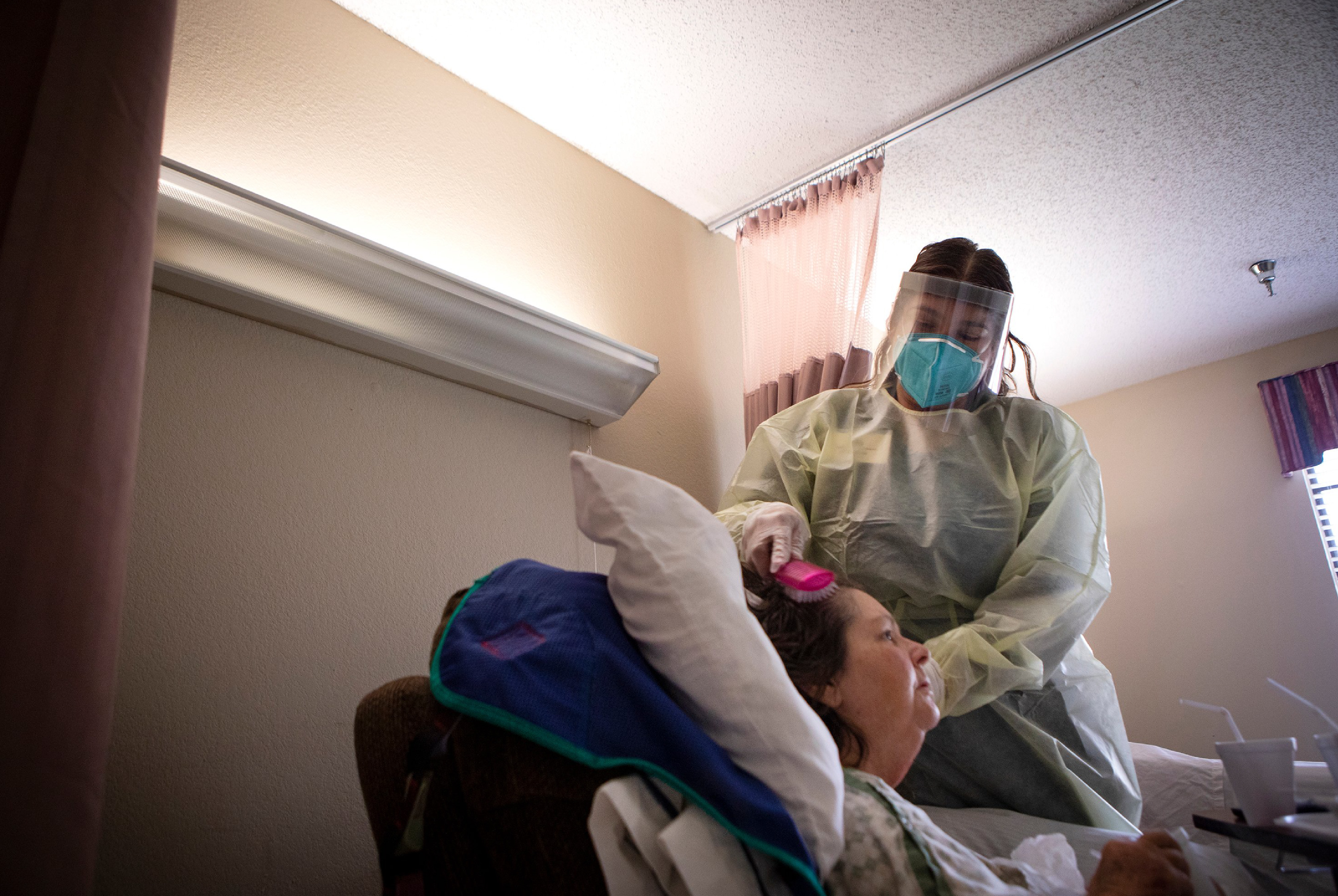
Amistad nurse Maria Perez remembers the pain of seeing residents waving at their loved ones through windows as the death count began to rise across the nation.
“You can see the toll that it takes on the residents,” Perez said. “But you know, unfortunately, it was for their own safety.”
Administrators at facilities across Texas began daily phone calls with one another and with the Texas Department of State Health Services. New rules from Austin and Washington D.C., changed often, sometimes daily, as officials desperately tried to keep the virus out of the facilities.
Administrators at Focused Post Acute Care Partners, which runs 31 facilities in Texas, had to communicate new rules about protective gear and other protocols to some 2,300 employees nearly every day, said CEO Mark McKenzie.
“Once we got into the flow of it, it almost felt like Groundhog Day, every day,” McKenzie said. “We’d wake up, we’d have two new modifications to the modifications from yesterday. Early on, we were just all stunned.”
Hopkins described the first few weeks as pure chaos: “It was just like a bunch of pigs on roller skates, you know. We were just going all different directions.”
Panic in the springtime
Hopkins said he and other nursing home administrators felt they were fighting an invisible enemy. With no COVID-19 testing being done for asymptomatic people in Texas in the early months, it was impossible at first to tell whether the virus was getting past their safeguards.
Then residents began dying, and the deaths mounted throughout the spring. Something close to panic began to creep into some communities.
Shortly after the Focused Care nursing home in Crane County, near Odessa, reported its first case in May, County Judge Roy Hodges issued a court order to quarantine residents and staff until everyone could be tested.
“I was shocked when ... two armed law officers showed up at our doors in Crane and refused to let anyone in or out. They blocked the front and back doors of our community,” McKenzie said in an editorial at the time.
Three dozen employees — more than half the facility’s staff — quit that day, fearing that one day they’d go to work “and would never get to home again,” McKenzie said.
No one had tested positive in Crane County in nearly two months. Before that, the county had only two confirmed cases. When Focused Care’s residents and staff members were tested that week under a court order, 21 people were confirmed to have the virus, according to reports. Among the five employees infected was a local high school student. Traditional graduation celebrations for the school district were canceled.
Nursing home officials and residents breathed a sigh of relief when Gov. Greg Abbott ordered testing for all residents in May.
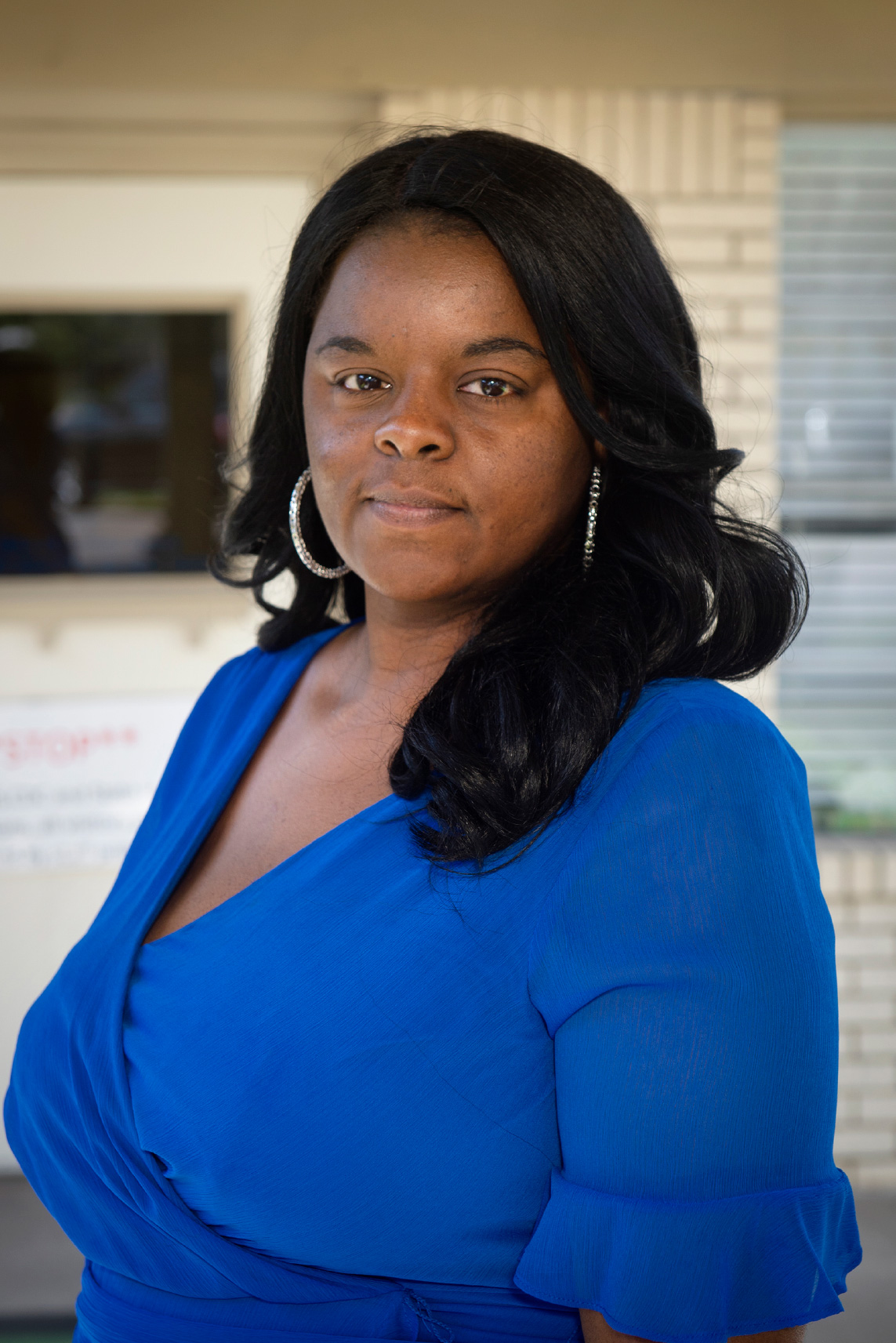
When the first round of test results came back at Focused Care at Corpus Christi, none of the 47 residents or 53 staff members were positive, said Taneicha Grady-Bravo, the facility’s executive director of operations.
Upon hearing the news, she said, the staff let out a loud cheer, exchanging air hugs and high fives across the room.
Grady-Bravo sat down in her office and cried.
“That was a turning point for us to say, ‘OK, we got this, let’s go.’”
The relief didn’t last. Within a couple of months, the Corpus Christi area became a hot spot, grabbing national headlines when a 6-week-old infant died from the virus and again when nearly a quarter of all tests citywide came back positive for the virus.
That’s also when the first COVID-19 case showed up at Focused Care at Corpus Christi. There would be 18 more infections and four virus-related deaths among its residents by the end of September, according to state data.
A frightening summer
Lynda Langford was terrified.
At the end of July, Texas nursing homes recorded their deadliest seven-day stretch since the pandemic began, with 423 deaths reported.
And Langford was about to move into one.
“You’d read the news, and the nursing homes were the worst places for COVID,” Langford said. “In San Antonio, the big city next to us, they were having horrible times. Just running rampant through a whole building. And a lot of [nursing home residents] didn’t survive. That scared me.”
After a few days in an assisted-living facility, Langford moved into Amistad in August. She went immediately into a quarantine unit for two weeks.
When she saw all the safety protocols the staff were going through every time they came into her unit, she felt safer.
“I’ll never forget, they’d come in my room and do whatever they were going to do, and then they’d walk out and take all that stuff off — that blue gown, the masks, all of that — and every time they came into my room they’d do that,” Langford said. “And I just couldn’t believe it. But they did, and I never saw them cut corners.”
She often sat at her window, which faced the street in front of the facility entrance, and watched ambulances come and go at all hours of the night. She knew many of the people inside the ambulances were COVID-19 cases. Several, she said, didn’t come back.
“That's a horrible thing, to watch those ambulances go by,” she said.
Socializing in the common areas and the dining room wasn’t allowed, per COVID-19 regulations, but when one of the residents died, Langford said, everyone would stand in their doorways, cry together and talk about happy memories with their friend — a socially distant memorial.
Near the end of summer, the forced isolation of nursing home residents was drawing increasing criticism across the nation. That led to state and federal officials making the decision to allow “essential caregivers” — usually a friend or family member who regularly visited before the lockdowns — to be trained, screened and allowed regular visits with their loved ones inside the nursing homes.
In August, Abbott began permitting nursing homes that had no active COVID-19 cases among residents, and no cases among staff for the previous two weeks, to allow limited outside visits.
Only a small portion of the state’s nursing homes met that criteria at the time.
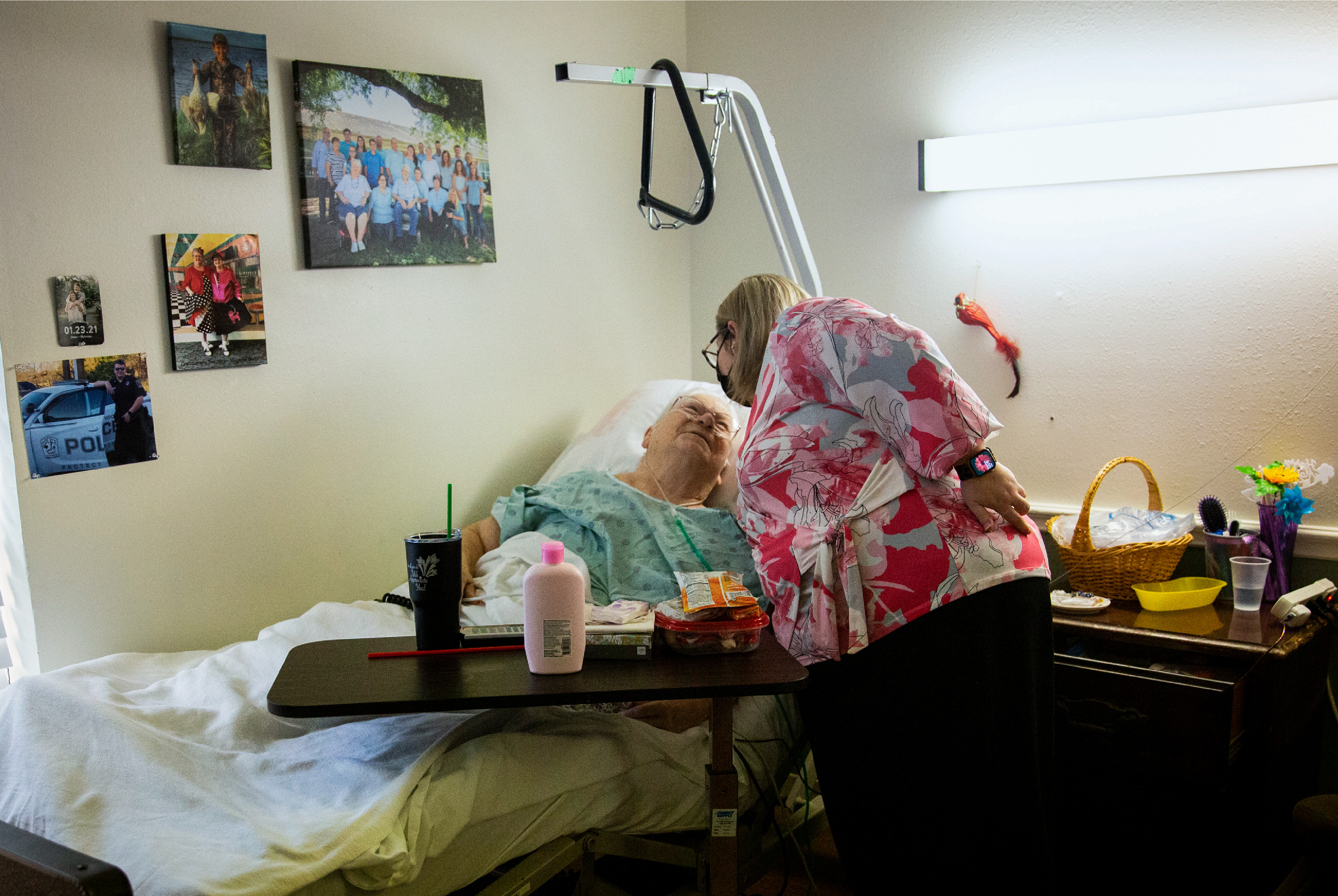
At Focused Care at Brenham, the change was immediate, said Jeannie Dupree, executive director of operations. She remembers a man who was in hospice care and stopped eating when his wife couldn’t visit him every day after the lockdowns began.
“But then once we encouraged her to apply to be an essential caregiver, he perked up,” Dupree said. “It was such a radical change that they’re actually looking at getting him off hospice.”
Anxious holiday season
Langford celebrated her 74th birthday at the nursing home in October. Her husband, their son and his wife and children were there, along with friends.
“We had my birthday party through the window. All my friends came and stayed outside, I was inside,” she said, chuckling. “It’s better than nothing, but it’s not good.”
For Langford, it was the second milestone she’d missed because of the pandemic. In May, she and her husband had planned a large family celebration for the couple’s 50th wedding anniversary at their favorite place along the river north of Uvalde, but they canceled it because of the pandemic.
Langford still wipes away tears when she thinks about it.
Throughout autumn, deaths across the state and the nation began to drop, and nursing homes in Texas saw the same decline.
In Corpus Christi, Focused Care’s Grady-Bravo said that by September, her staff was fighting exhaustion and burnout. The facility started trying to boost morale through “virtual vacations” — themed weeks with food and music representing various vacation spots around the world. The first one was Hawaii.
“They absolutely loved it,” Grady-Bravo said of residents and staff. “We still do it. Everyone looks forward to it.”
The holidays brought a fresh round of challenges as state and federal officials told nursing home operators that residents must be allowed to leave and go visit family over Thanksgiving and Christmas.
It was welcome news for some, but it brought fears of a holiday-fueled “third wave” of COVID-19 deaths.
“Sometimes there’s a disconnect between the directive and what a lay person would think is a common-sense approach, and we have to follow the directive,” McKenzie said. “They could take their loved ones home during the holiday, and we couldn’t stop it, and they could bring them back.”
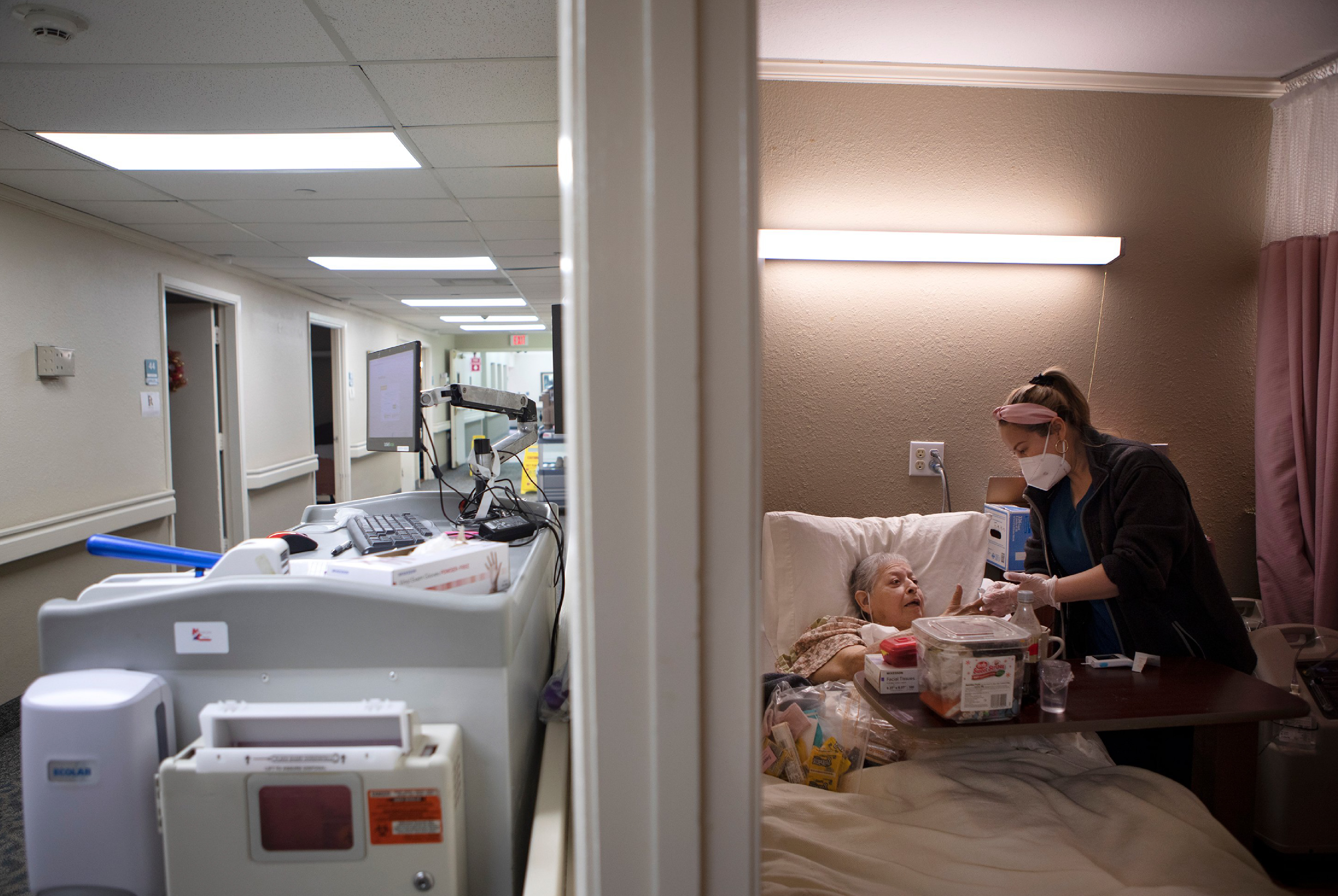
At Focused Care at Summer Place in Beaumont, two residents tested positive for COVID-19 after one of them went home for Thanksgiving, McKenzie said.
In Uvalde, Langford celebrated the holidays while separated by glass from her family, who again gathered outside the window. But she avoided catching the virus, even as the nation endured its highest-ever spike in deaths and hospitalizations.
The week before Christmas, the first batch of the coronavirus vaccines began arriving at Texas nursing homes.
Meanwhile, at Texas nursing homes, deaths spiked a second time, with a high of 410 in one week in early January.
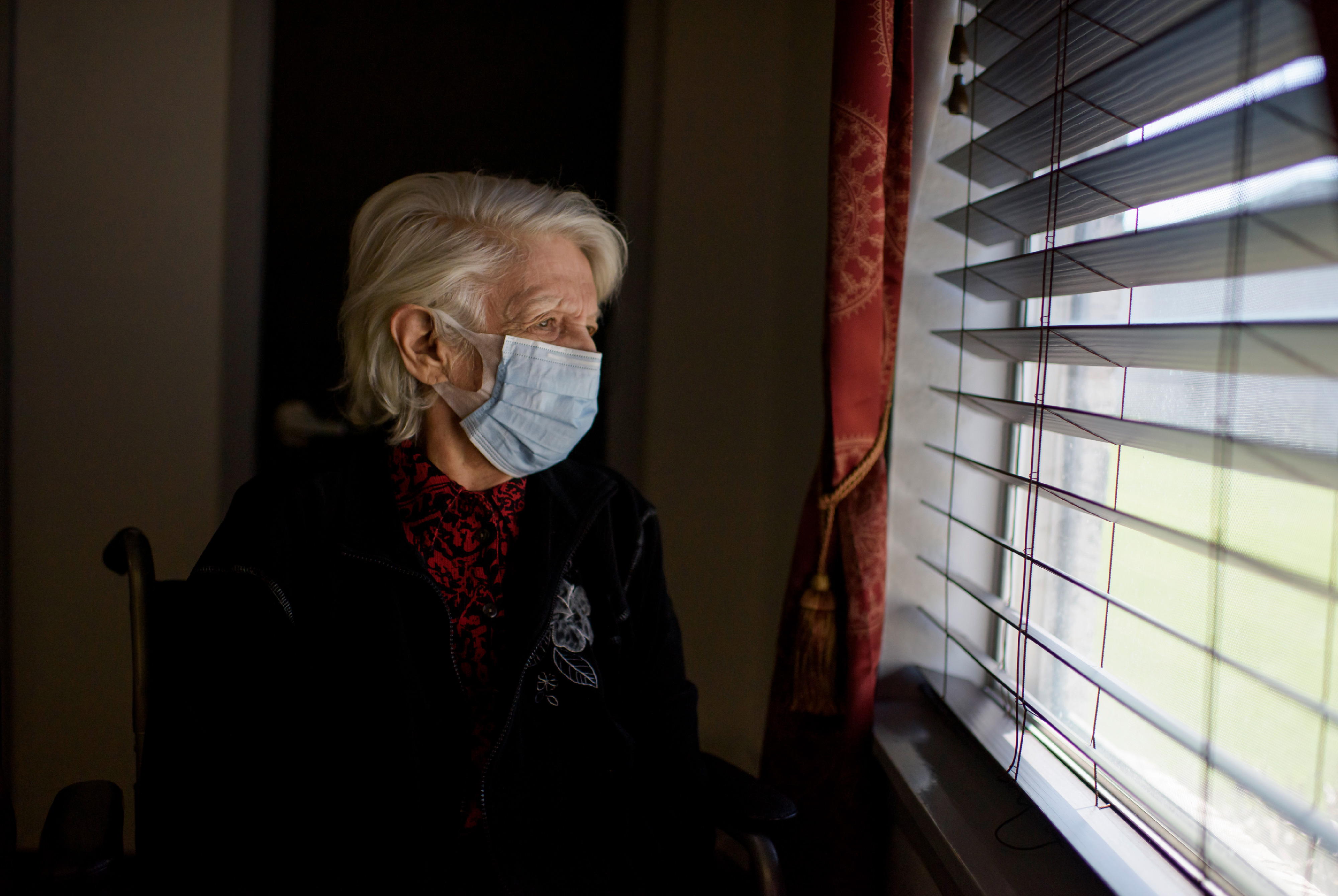
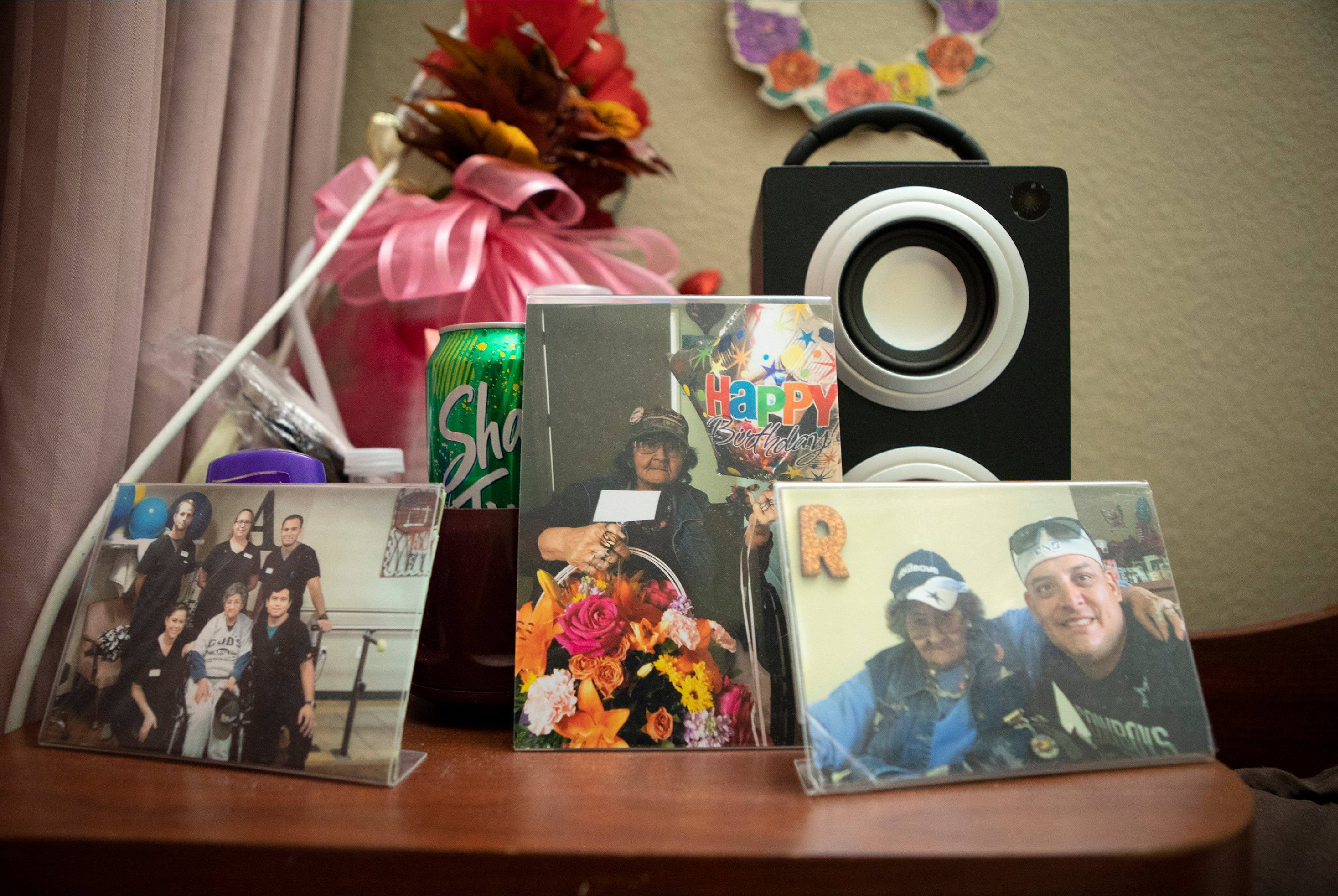
Vaccines bring hope
Amistad was among the first facilities in the state to receive vaccines, and staff began receiving doses on Dec. 23.
Langford didn’t need convincing when her turn came in January. She remembers taking the polio vaccine orally on a sugar cube while she was in high school in the 1960s and how that saved her generation from a childhood illness that paralyzed 2% of those who contracted it.
“I didn’t hesitate,” Langford said. “I’ve got a better shot with the vaccine than I do without it. I feel like I can get the virus now and live through it.”
More than 70% of the nursing home’s residents, or their families on their behalf, agreed to the shot when it was first offered, said Arizmendi Mirelez, the Amistad facility administrator.
But Hopkins said staffers were harder to convince. Only about a third of the staff agreed to get vaccinated, although those numbers went up “once more people started getting vaccinated and didn’t grow tails,” he said.
As of mid-March, nearly 90% of the staff and residents at Amistad had gotten at least one dose. Meanwhile, Focused Care facilities reported more than 70% of residents vaccinated and more than half of its staffers. At least one Focused Care facility near the Panhandle has 90% of its staff and residents vaccinated, McKenzie said.
By April 6, 1,212 of the state’s 1,223 nursing homes had administered vaccines to residents or staff, according to the state health department. But the virus hasn’t been defeated in Texas nursing homes.

In mid-February, a historic snowstorm and freeze delayed a vaccination clinic at Focused Care Brenham, and shortly after, 18 residents and staff tested positive for the virus in the facility's only big outbreak since the pandemic began. Some of those residents had recently received the vaccine, but the injection may not have had not had a chance to become fully effective yet, Dupree said. Four of the infected residents died, although COVID-19 was not confirmed as the cause of death. Three of them had declined to be vaccinated, company officials said.
It was a critical reminder that in spite of the relaxing of state pandemic restrictions recently, her company had good reason to keep its protocols in place, she said.
“You realize that we definitely need to still keep our vigilance and keep everything going, because you never know,” she said.
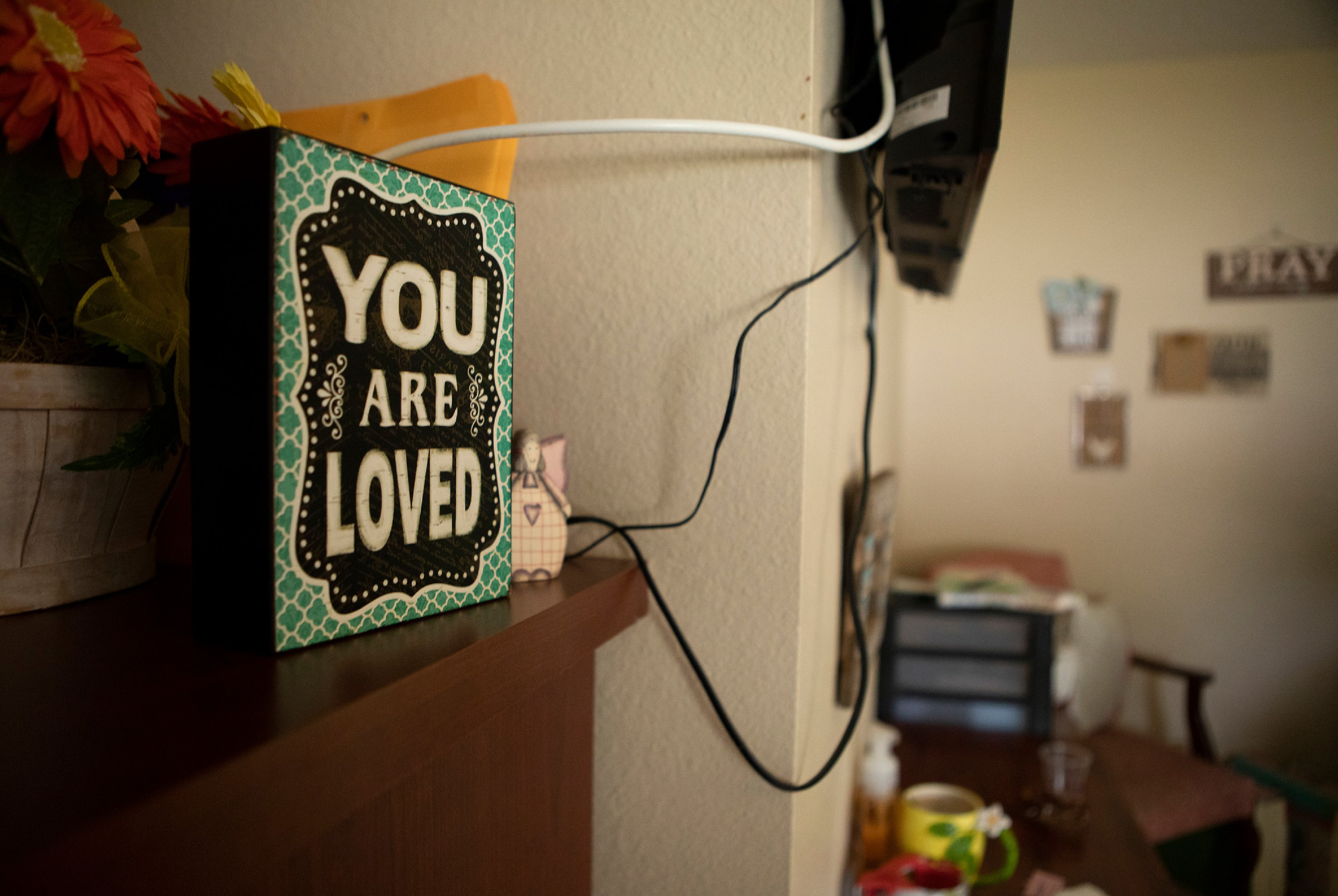
A long-awaited hug
With more residents being vaccinated and Texas removing restrictions on masking and business capacity, nursing home administrators celebrated a move in late March by state health officials to allow vaccinated residents to get unlimited close-up visits for the first time in a year.
Hopkins can’t wait to hear the sounds of a nursing home bustling with visitors, socializing and joking and bickering in the common areas, rather than the relative quiet of the last few months.
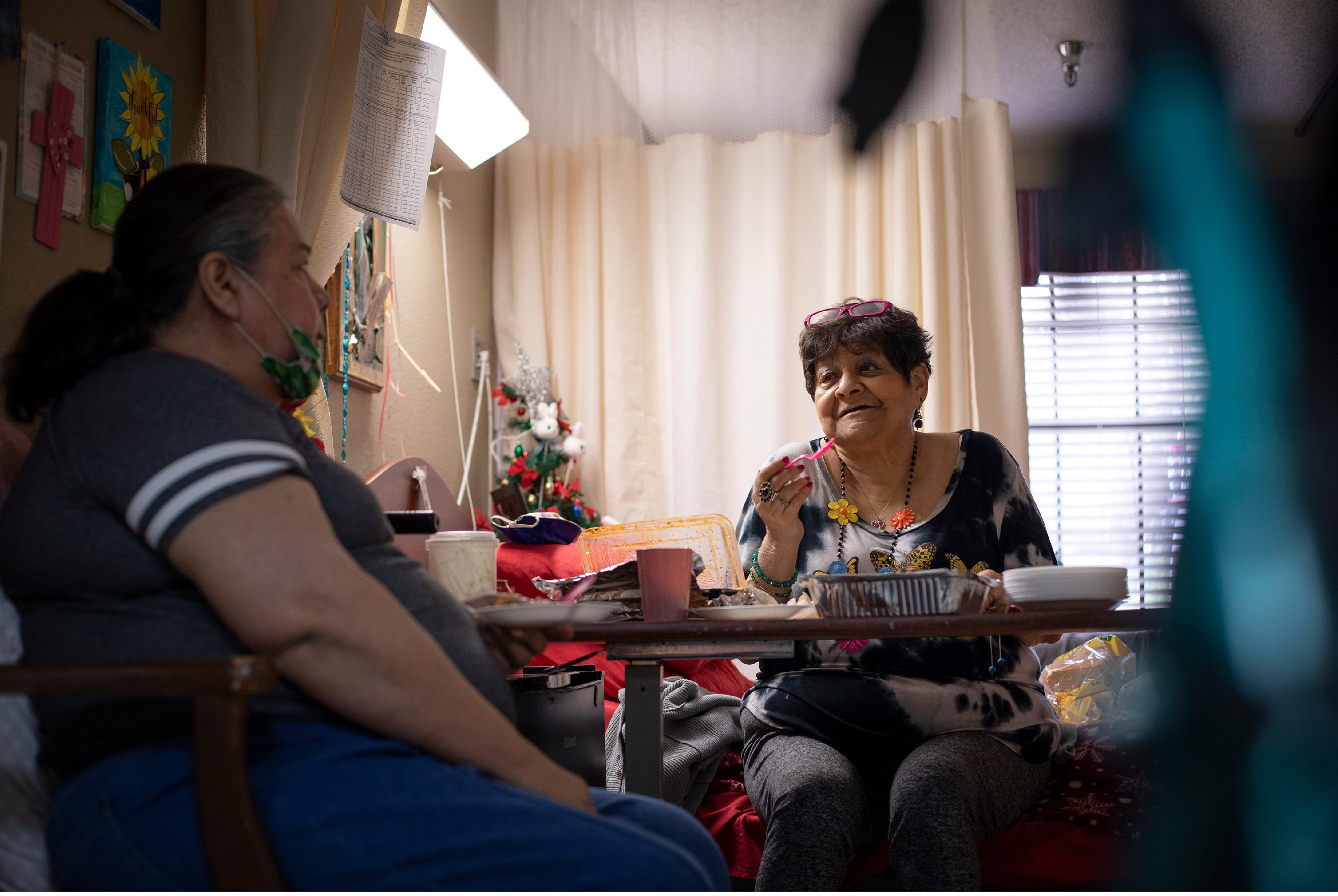
“When I walk into the nursing home, I want to hear it. I want it to be loud, you know? Something going on. I want to hear the residents in the dining room,” he said. “I like that kind of stuff. It’s just happy.”
Langford knows she’ll probably never move out of the nursing home — she doesn’t believe she’ll ever be able to safely be alone while her husband works on the ranch — but has high hopes for being able to embrace her new life there once the worst of the pandemic passes.
Her first wish is to celebrate her 51st wedding anniversary in May — and have the party that she had to cancel last year.
Earlier this month, she was finally able to hug her husband for the first time since last summer. It was a moment, she said, of pure joy.
“It felt great,” Langford said. “It was awesome.”
About the data
Each day, nursing homes report the number of residents who died due to COVID-19 to the Texas Health and Human Services Commission. Between May and July 2020, the Texas Department of State Health Services also provided data from nursing homes. DSHS gathers other state health statistics, including the reported COVID-19 deaths statewide.
The weekly death numbers published here were compiled by subtracting the cumulative number of nursing home resident fatalities reported statewide each Wednesday. The week of Texas’ winter storm in February, the state did not update nursing home COVID-19 data until Thursday, so that data was used instead.
Emily Albracht and Miguel Gutierrez Jr. contributed to this report.